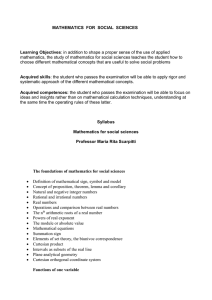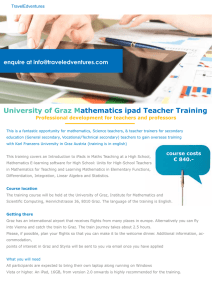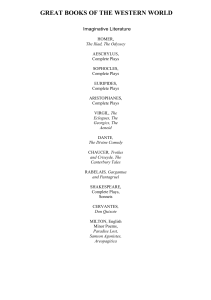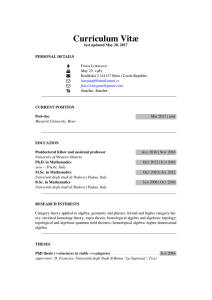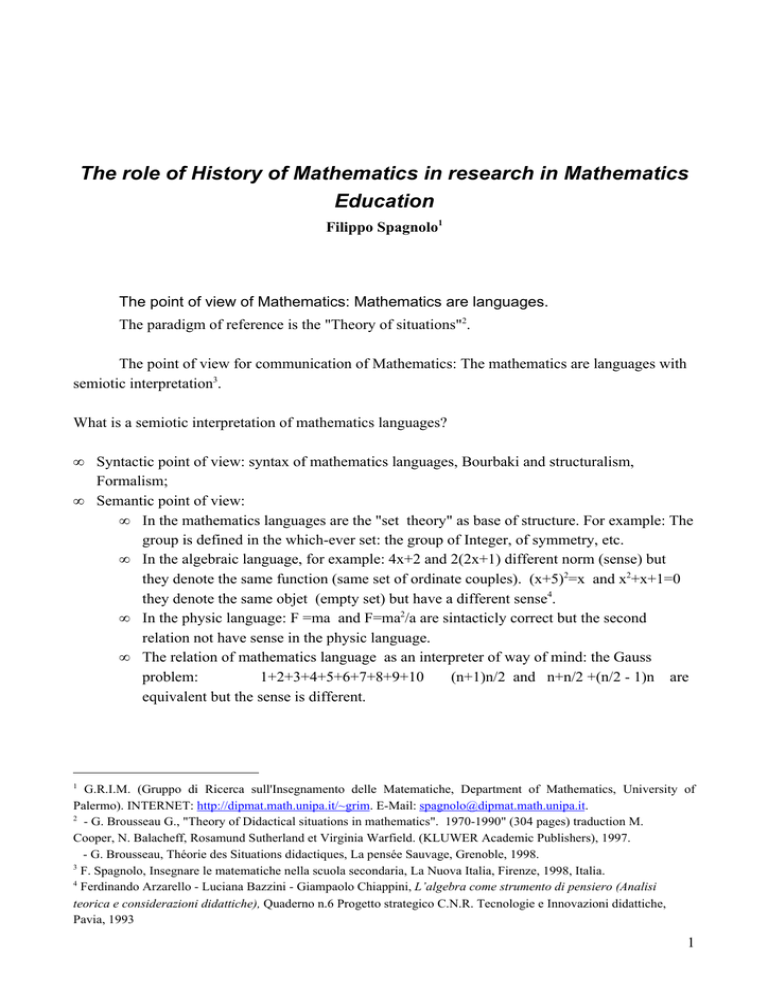
The role of History of Mathematics in research in Mathematics
Education
Filippo Spagnolo1
The point of view of Mathematics: Mathematics are languages.
The paradigm of reference is the "Theory of situations"2.
The point of view for communication of Mathematics: The mathematics are languages with
semiotic interpretation3.
What is a semiotic interpretation of mathematics languages?
•
•
Syntactic point of view: syntax of mathematics languages, Bourbaki and structuralism,
Formalism;
Semantic point of view:
• In the mathematics languages are the "set theory" as base of structure. For example: The
group is defined in the which-ever set: the group of Integer, of symmetry, etc.
• In the algebraic language, for example: 4x+2 and 2(2x+1) different norm (sense) but
they denote the same function (same set of ordinate couples). (x+5)2=x and x2+x+1=0
they denote the same objet (empty set) but have a different sense4.
• In the physic language: F =ma and F=ma2/a are sintacticly correct but the second
relation not have sense in the physic language.
• The relation of mathematics language as an interpreter of way of mind: the Gauss
problem:
1+2+3+4+5+6+7+8+9+10
(n+1)n/2 and n+n/2 +(n/2 - 1)n are
equivalent but the sense is different.
1
G.R.I.M. (Gruppo di Ricerca sull'Insegnamento delle Matematiche, Department of Mathematics, University of
Palermo). INTERNET: http://dipmat.math.unipa.it/~grim. E-Mail: [email protected].
2
- G. Brousseau G., "Theory of Didactical situations in mathematics". 1970-1990" (304 pages) traduction M.
Cooper, N. Balacheff, Rosamund Sutherland et Virginia Warfield. (KLUWER Academic Publishers), 1997.
- G. Brousseau, Théorie des Situations didactiques, La pensée Sauvage, Grenoble, 1998.
3
F. Spagnolo, Insegnare le matematiche nella scuola secondaria, La Nuova Italia, Firenze, 1998, Italia.
4
Ferdinando Arzarello - Luciana Bazzini - Giampaolo Chiappini, L’algebra come strumento di pensiero (Analisi
teorica e considerazioni didattiche), Quaderno n.6 Progetto strategico C.N.R. Tecnologie e Innovazioni didattiche,
Pavia, 1993
1
Use of Frege triangle
Sense (Sinn)
Denotation of
A expression
(Zeichen)
•
Denotation
(Bedeutung)
Pragmatic point of view: communication point of view, didactics point of view
In the history of mathematics5:
•
•
History of Syntax of mathematics languages: Bourbaki (History of mathematics6): Evolution of
Algebra:
• Law of composition: Egyptian and Babylonian have a complex system of norms
calculation on Natural numbers >0 and Rational numbers >0, Commutativity of product
of rational numbers (Euclid, Theory of magnitude), Diofanto, - 2 pages - , XVII century
law of composition in algebra (Gauss), theory of substitutions (Lagrange), Galois
(groups of substitutions, XIX century (2 pages). (9 pages)
History of semantic of mathematics languages: Are the books with titles "History Mathematical
Thought"7. The history of thought scours mathematics languages analysing the "senses"
attributes to mathematics concepts, before organically they could to play the role in
mathematical language organized.
• In this way is the book "History of mathematics, history of problems8" (The interirem commission, Ellipse, Paris)
• The history of function concept (also in Piaget, Epistémologie et psycologie de la
fonction, Etudes d'épistémologie génétique, 1968, Presses Universitaries de
Frances). The point of view of psychology is privileged. Every study of
mathematics concept are completed with history study.
5
F. Spagnolo, Storia e Didattica, Ricerca in Didattica, n.2, IRRSAE-Sicilia, to appare.
N. Bourbaki, Elémentes d'histoire des mathématiques, Hermann, Paris. (Italian : Elementi di storia della matematica,
Feltrinelli, Milano, 1963).
7
Examples: M. Kline, Mathematical thought from Ancient to Modern Times, 1972 (Italian: Storia del pensiero
matematico, Einaudi, 1991, Torino).
8
The inter-irem commission, History of mathematics History of problems, Ellipses (32, rue Bargue, Paris 15°), 1997.
(Version française: Histoire des mathématiques, histoire des problèmes)
6
2
•
•
•
•
•
•
Morris Kline, Mathematical Thought from Ancient to Modern times, 1972. The
history of semantic and syntax are not completly separated in this occasion.
The history of Eudoxe-Archimede Postulate (see Spagnolo, Les obstacles
epistemologiques: Le postulate d'Eudoxe-Archimede, 1995);
History of pragmatic of mathematics languages: There is the history of communication of
mathematics.
• What was the Know (Savoir, Sapere) in a determinate historical period?
• What was the real know of students?
In this perspective they are many important the historical sources: books, official
curruculum, register of teachers, reviews of mathematics and reviews of mathematics
education. (In Italy they are reviews of mathematics education since 1870. In Palermo the
review "Il Pitagora" (1874-1919)9)
In history of Algebraic language in western culture they are 3 periods:
Rhetorical algebra: no symbol, natural language (Eastern Arabs);
Syncopate algebra: natural language with abbreviations for the operations and for relations more
frequent (Diofanto, West Arabs);
Symbolic algebra: symbol in all relations (Indian, after XVII century in Europe, Viète).
A classification more subtle of algebraic languages10
Natural
Geometry
languag
es
Rhetorical Yes • They argue with pre-Euclid
Algebra 1
instruments
• They solve a problem at a
time
Rhetorical Yes • They argue completely with
Algebra
Euclid instruments
2
• They solve a problem at a
time
Yes • They solve a problem at a
Syncopate
time
Arithmetic
Examples
Language of support:
procedural
Chinese,
Babylonian,
Egyptian
Language of support:
procedural
Classic Greeks,
Euclid
Introduction of
abbreviations for
Diofanto
9
F. Spagnolo-T. Marino, Alcune considerazioni storiche su "IL PITAGORA" (Giornale di Matematica per gli alunni
delle scuole secondarie), Comunicazione convegno storia della didattica, Milano aprile 1991. Quaderni del Gruppo di
ricerca didattica di Catania e Palermo, settembre 1991.
F. Spagnolo, T. Marino et Alii, Considerazioni su alcuni articoli di Didattica della matematica della
rivista "Il Pitagora", La Matematica e la sua didattica, ed. Pitagora, Bologna, n.4, 1994.
10
E. Malisani, Storia dell'algebra, Quaderni di Ricerca in Didattica, n.5, Palermo, 199
3
Algebra
1
Syncopate
Algebra 2
unknown and its powers
Yes
• They argue completely with
Euclid instruments
• They solve classes of
problems
Introduction of names for
the unknown and its
powers
Syncopate
Algebra 3
Yes
• They argue completely with
Euclid instruments
• They solve classes of
problems
Syncopate
Algebra
4
yes
Symbolic
Algebra14
no
• They argue completely with
Euclid and algebraic
instruments
• They solve classes of
problems expressing
formulas
• They argue completely with
Euclid and algebraic
instruments
• They solve classes of
problems expressing
formulas
Introduction of
abbreviations for
unknown, its powers and
some relations as the 4
operations, equality and
root
Introduction of a
particular notation for the
unknowns, its powers,
some relations as the 4
operations, equality and
root
Introduction of symbols
for the unknowns, its
powers and some
relations
Fibonacci 11,
Trattato
d’algibra12
(anonymous of
XIV century13)
Algebristi of
500
Bombelli
Viète
The development of algebraic thought in the Frederic's period: A dispute between
Abacists and Algorithmists.
The historic contest.
The target of this paragraph is to try to understand the passage to syncopated algebra 2 about
the period of Fibonacci. To do this we will try to introduce the develop of Algebraic Thought in
Sicily in the Frederic's period (Frederic II was born 26.12.1194, dead in the 129115) and such
thought had developed around the algebra's history.
11
They uses some names to call the unknown in the ending of Liber Quadratorum, but they argue completely with
geometry.
12
They associate in all work the unknown and its powers with particular names, but they argue with geometry.
13
Anonymus, Il Trattato d’Algibra (manuscript of XIV century). With introduction of R. Franci and M. Pancanti, Siena,
Quaderno del Centro di studi della Matematica Medioevale, 18, 1988.
14
They comes introduced the symbolic algebra without other levels since the present work stops to introduction of
symbol.
15
D. Abulafia, Frederic II (Un imperatore medievale), Einaudi, Torino, 1995.
4
To argue this hypothesis is a enough difficult enterprise as they no exist historical
documents to permit we have direct assertions. The are only indirect documents:
1) Documents relative to cultural situation before Frederic II 16;
2) Testimony of Leonardo Pisano (called Fibonacci), mathematical lived between second
half of 12° century and second half of 13° century, through our works about questions asked by
"Giovanni from Palermo" and Teodoro in occasion they visit at Pisa with the emperor Frederic II17.
(Giovanni from Palermo and Teodoro was part of court of Frederic II).
The problems suggested by Giovanni from Palermo and by Teodoro, expressed in symbolic
language of contemporary algebra, are:
1- To find a number x such that the quantity x2+5 e x2 -5 they be squares.
2- To solve equation x3+2x2+10x = 20.
The 2° problem (suggested by Teodoro) was in Euclid's geometric tradition and wasn't
particularly innovative about procedure resolutive. Fibonacci proves only root can't to belong to
irrational numbers studied in Euclid's Book X and then expresses the solution in sexagesimal
fractions according Egiptian tradition.
The analysis of 1° problem is more interesting why it individualizes two different
conceptions: Rhetorical algebra of abacists and syncopate algebra of alghoritmists.
The Arabs of eastern (abcists) solved the problems one by one without to suppose the
possibility of generalizations (they no posses instruments by symbolism.
Giovanni from Palermo, in line with this tradition, lays the problem to Fibonacci too knew
the solution of other similar problems (example: x2 -6=a2, x2 +6=a2 ).
In the resolution of problem, Fibonacci excludes immediatly the integer solution (see the
preceding propositions of XIV of Liber quadratorum. The reasoning expressed with contemporary
language is:
All numbers of form a2 - b2 they say congruous but more accuracy18:
"A number C, integer or rational, they say congruous if exists a square number, integer or rational,
such that added and subtracted C they obtain still a square. A number C is so congruous if
y2 − C = x 2
and only if the system: 2
2
y + C = z
16
1) Ernest Kantorowicz, Frederic II imperatore, Ed. Garzanti, Firenze, 1988. 2) David Abulafia, Frederic II (Un
imperatore medievale), Ed. Einaudi, Torino, 1995. 3) Gino Loria, Storia delle Matematiche, Vol. I (Antichità, Medio
Evo, Rinascimento), Ed. Sten, Torino, 1929. 4) Michele Cipolla, Il contributo Italiano alla rinascita della Matematica
nel Duecento, Discorso della seduta del 14.1.1934 presso la R. Accademia di Scienze, Lettere e Belle Arti di Palermo.
17
Léonard de Pise, Le Livre des nombres carrés (Liber Quadratorum), Libraire Scientifique et Tecnicque Albert
Blanchard, Paris, 1952.
18
La definizione di numero congruo la riportiamo dal lavoro di R. Franci (Numeri congruo-congruenti in codici dei
secoli XIV e XV, Bollettino di Storia delle Scienze Matematiche, Anno IV, n.1, La Nuova Italia Editrice, 1984);
5
admits solutions integers or rationals. If C is a congruousus number the pertinent power square
number tey say congruousus square or congruousus.”
To solve the proposal problem is to solve the system of equations:
1) equation x2 -5 =a2, equivalent to x2 - a2 =5;
2) equation x2 +5= b2, equivalent to x2 -b2 =-5.
x
2
3
4
5
3
4
4
...
In the first equation, we consider the possible cases:
A x2 -a2
1
3
1
8
1
15
1
24
2
5
2
12
3
5
...
...
The numbers 3 and 2, 4 and 3 are possible solutions for first equation since the solution is 5,
but they are solutions of second equation?
We must to count on the other expression x2 +5=-a2. This expression they haven't integer
roots is sufficient to transform x 2 -b2 =-5. In the table already written they see immediately that they
can't negative solutions. They will must to make tables of congruous numbers to can to locate the
solution. Fibonacci follows a analogous reasoning. The solution of Fibonacci is a rational number
express in the fraction form 41/12. Fibonacci not provide a demonstration , of course he have make
use of tables of congruous numbers were known at the time and they not came related in the Liber
Quadratorum (cfr. Franci, 1984). Fibonacci say that the numbers of his numerical check 31, 41, 49
are in the arithmetic sequence of ratio 720:
(1) (41/12)2 +5 = 1681/144 +5•144/144 = (49/12)2
while x=41/12 and a=49/12;
(2) (41/12)2 -5 = (1681-5•144)/144 = (31/12)2
while x=41/12 and b=31/12;
The expressions (1) and (2) they can also to write respectively:
412 + 5•122 = 492
1681+720=2401
2
2
2
41 - 5•12 = 31
1681-720=961
they give to can locate, in table for research of congruous numbers, a possible solution is:
x
a
x-a2
x
a
x- a2
6
412
312
720=5•122
412
492
-720=5•122
The research of congruous number in our case is 720=5•122 consequently they are
determining to next research of solutions and also they are useful the consideration that the square
of numbers 31, 41, 49 are in sequence of ratio 720. In the proposition XIII Fibonacci proofs the
number finded must be in the form 5•k2. He proofs in XII proposition the congruous number by
power square is congruous number.
Single problem
Class of problems.
History - Pupils - Teacher - Research in Mathematics Education
Point of view of Researcher in
Mathematics Education
(Communication of mathematics).
By to argue the researches and for a
possible reproducibility.
•
Point of views of Teacher:
• For to restatement (focus)
significative "didactics situations"
for teaching/learning.
• For the epistemology of teacher.
•
•
•
•
•
•
Point of view of pupil
•
•
History of syntax: conceptions that they use to
syntactical adjustment of mathematics language.
History of semantic: conceptions that to use to a-priori
analysis of behaviour of pupils.
History of pragmatic: study of phenomena of teaching
concerning "didactic transposition".
History of syntax: personal use of teacher but also for
to check the analysis a-priori and/or "didactic
transposition".
Chronological history concerning mathematics
languages.
Thematic history: history of demonstration (to argue,
to deduce, to infer), history of limit concept, of
infinity, of rigour, of function, of natural number, etc.
The recovery of know of discipline in the point of
view more general: historical-philosophical
He inserts the study of mathematics languages in
cultural dimension
He inserts a temporal dimension in the construction
of mathematics languages
7


